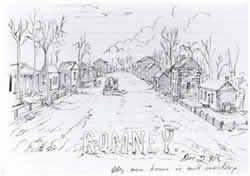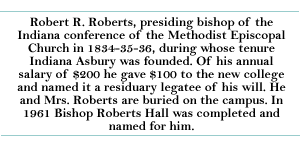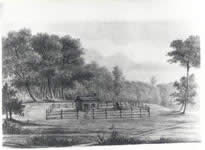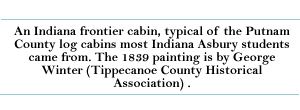|

Pages:
<< Back 1
2 3 4
5 6 7
8 9 10
Next >>
The
Conference took final action on the proposal at its Indianapolis
meeting in October 1836, when it decided to establish "an institution
of the first order. .. upon an extensive plan of operation and equal
to any College or University in the valley of the Mississippi."
A committee was appointed to draw up a charter and see to its approval
by the state legislature. Another committee would evaluate the offers
of the various towns competing for the location of the institution,
considering such matters as the amount of money subscribed by each
community as well as the general state of health and morals! Somehow
the small Putnam County town of Greencastle managed to raise $25,000
to induce the committee to select it over Indianapolis, Lafayette,
Madison, Rockville, and Putnamville as the site for the new college.
Another factor was its alleged healthfulness. One local booster,
Dr. Tarvin Cowgill, is supposed to have said that "people never
die in Greencastle, although for convenience they have a cemetery
there."


The charter for Indiana Asbury University, as the new institution
was officially named in honor of Bishop Francis Asbury, was prepared
and on January 10, 1837, duly approved by the Indiana General Assembly.
Despite its sectarian sponsorship, the "Seminary of learning"
was to be founded "for the benefit of the youth of every class
of citizens, and of every denomination, who shall be freely admitted
to equal advantages and privileges of education." Again the
charter refers to "an extensive University or College Institution
...to be conducted on most liberal principles, accessible to all
religious denominations and designed for the benefits of the citizens
in general." While some historians point to this statement
as reflecting the liberality of the founders' intentions, others
suggest that it merely represents the lip service to nonsectarianism
required to win legislative approval.
The charter named 25 trustees to be invested with the direction
of the university, particularly to appoint the president and his
assisting faculty, and to begin the enterprise. Vacancies were to
be filled by the Indiana Conference of the Methodist Church or such
other annual conferences as might be established in the state. In
addition, the conference or conferences were authorized to appoint
nine visitors, who would report annually on the condition of the
university and, together with the trustees, make up the Joint Board
or governing body of the institution. Clearly Indiana Asbury University
was conceived at its origin as a creature of the Methodist Episcopal
Church.


In
1837 Greencastle, the site for the new university, was still a raw
frontier village. It was formed from land given to the newly created
Putnam County for its seat of government by pioneer settler Ephraim
Dukes in 1823. Surrounded by small log or frame houses scattered
along unpaved streets and about 20 or so stores located in a square,
the one story, brick, hip-roofed courthouse was the focus of business
activity.
In his diary, first teacher Cyrus Nutt
records his impression on arrival in 1837:
Greencastle was only about ten years old, small and rough. The
site was by no means the most pleasant, it being a succession of
hills and hollows, the streets were without grading, or side walks
except about the public square. Six months in the year mud was an
abundant article. The population was about five hundred. Yet this
place and its vicinity subscribed twenty five thousand dollars to
obtain the location of the University and it was exceedingly fortunate
for that place that it succeeded in its application. Had it failed
the county seat would probably have been moved to Putnamville, and
Greencastle would to day have been numbered with the things that
were....
Likewise President Matthew Simpson
shares this revealing impression of the community when he arrived
in 1839:
The houses were primitive, and the people largely from Kentucky,
Tennessee, and North Carolina. There were three church edifices,
a Baptist, a Presbyterian, and a Methodist, all of them very plain
.... While the people were both respectable and pious, society was
in almost every sense in a very primitive condition.
 
The first meeting of the trustees was held in the still-unfinished
Methodist church building the first week of March 1837. Of the 16
men present, 15 were from Greencastle or Putnam County. Bishop Robert
R. Roberts, who had presided over the 1834, 1835, and 1836 sessions
of the Indiana Conference which had taken the decisive steps to
establish the university, was absent, as were other trustees from
parts of the state too remote for easy access to Greencastle.
Back
to Top
Pages:
<< Back 1
2 3 4
5 6 7
8 9 10
Next >>
|






